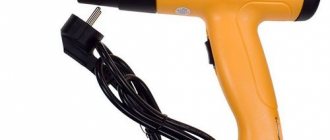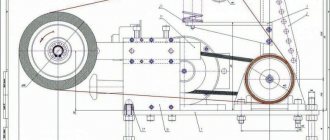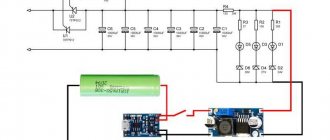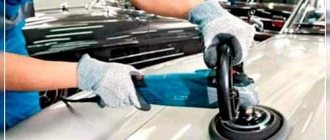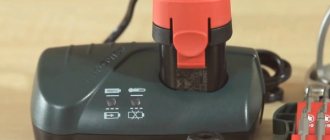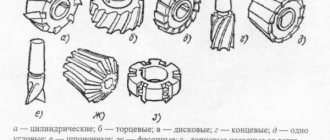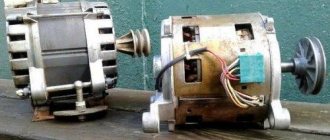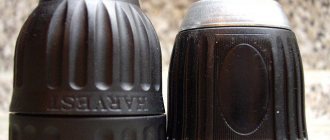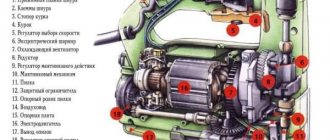Planers
A planer is a hand-held woodworking tool for planing.
Using a plane, they impart the desired roughness to the surfaces of wooden parts, making them flat and straight. Planers are also used to reduce the size of parts and create long recesses of various shapes in them. With each passage along the surface, this tool cuts off a layer of material with a thickness determined by the amount of extension of the cutter, as well as its angle of inclination. The most necessary planes in a home workshop are an end plane for trimming the edges of wood and a jointer for longitudinal planing. These tools have high-quality steel knives and adjusting mechanisms that regulate the amount of wood removed. You can also supplement your tool kit with a sherhebel for straightening the edges of long boards; a chisel for cutting grooves; carpenter's scraper for cutting and smoothing curved surfaces.
DIY car repair tool. Straightening
Devices for repairing dents and body defects are varied. Straightening tools are presented:
- hammers;
- spoons;
- anvils;
- notch blocks.
The most optimal options for straightening hammers are considered to be double-sided tools with sides of different shapes. Straightening hammers differ from other hammers in weight and materials. To ensure the ability to straighten dents of various sizes and shapes, you should purchase a set of straightening hammers.
For do-it-yourself body repairs, straightening hammers are used in combination with an anvil or with various blocks designed to soften impacts.
Another tool for car body repair, related to straightening, is represented by a spoon. It is designed for straightening small flat tubercles by distributing the hammer blow over an area. Moreover, you can use a regular hammer with this tool, but sharp folds must be processed with a straightening hammer before using a spoon.
Techniques for making tools for working with metal
First of all, the tool must meet high requirements that allow you to work with strong and durable material. Tools for metal processing are made using the following methods:
- burning;
- hardening;
- forging using a press;
- grinding;
- hot stamping of hardened steel;
- induction hardening;
- metallization.
Such methods are necessary to give the working surface of the tool additional strength. The resulting equipment must have excellent cutting properties, as well as increased strength.
Main types of instruments
All equipment for metal processing is divided into several main groups, according to the method of influence:
- Pipe cutters. This is a group of equipment that is designed for cutting pipes of various thicknesses and diameters.
- Cross mixer - necessary for creating grooves in metal workpieces.
- Drill stand. There is a drill in it and it is possible to fix the workpiece.
- A die is used to cut external threads. A die holder is made for them.
- Goniometer. This is a measuring device, an analogue of the well-known protractor.
- A soldering iron is used to join metal parts.
- Hand hacksaw for metal. Designed for cutting metal, both sheet metal and small pipes.
- Metal scissors. Designed for cutting sheets that are not too strong.
- Vise - necessary for fixing the workpiece.
- Milling cutters. They work with different surfaces and can be cylindrical, end, disk, end, or conical.
All tools are used in industry and in everyday life. Many of them are used in combination.
The Complete List of Tools You Need to Create Almost Anything
Make magazine is a source of invaluable knowledge and a hub for connecting a vast community of creators around the world. In 2011, a special issue was published, which contained comprehensive knowledge on filling a universal workshop with tools, where you can create almost anything. The focus of this release is a comprehensive list of all required equipment. We translated it into Russian and are in a hurry to share it with you!
In addition to the names of the instruments, the original list also shows the relative importance of their availability, as well as the minimum and maximum prices for each item in dollars. We did not overload the list with this data, because what is much more important is that the vast majority of its items are relatively inexpensive and accessible tools that allow you to quickly and easily perform complex technological operations that were until recently inaccessible to ordinary people. Indeed, we are entering a new era of local fabrication of things, replacing the post-industrial economy, because independent creation of things is becoming more accessible than ever to millions of people who are ready to learn and master new technologies and production operations in the course of implementing their creative projects. So, here is a complete list of equipment that will allow anyone to create literally anything with their own hands.
Hand tools
- Utility knife
- Breadboard knife
- claw hammer
- Scissors
- Round hammer
- Diamond sharpener
- Wire brush
- Nail puller
- Ladder
- Hand trolley
- Blacksmith Hammer
- Rubber mallet
- Hacksaw for metal
- Hacksaw for narrow spaces
- Hole punching tool
- Set of punches and chisels
- Set of keys and sockets
- Torque wrench
- Hexagon set
- Torx key set
- Mini Hexagons
- Combination wrenches
- Self-clamping pliers with long nose, large and round profile
- Small and large needle nose pliers
- Pliers
- Adjustable wrenches
- Crowbar / crowbar
- Pipe cutter
- Glass cutter
- Bolt cutter
- Sheet metal shears
- Wood hacksaw
- Hand jigsaw
- Core drill set
- Hand saw
- Taps and dies
- Deburring cone
- Deburring Tools
- Drilling depth limiters
- Vise
- C-clamp
- Quick clamps
- Cam puller
- Files
- Hydraulic floor jack
- Pull hoist/lifting winch
- Phillips and slotted screwdrivers
- Jewelry screwdrivers
- Propane torch
- Thermal gun
Power tools
- Cordless screwdriver
- Band-saw
- Reciprocating saw
- Miter saw with horizontal movement
- Hand circular saw
- Jigsaw
- Vertical drilling machine
- Set of drills
- Plunge router
- Lathe
- Semiautomatic MIG welding machine
- Consumable electrode welding machine
- Strobe
- Adjustable electric stove
- Bormashinka
- angle grinder
- Sharpening machine
- Belt sander
- Belt Disc Sanding Machine
- Disc grinding machine
- Orbital sander
- Milling machine
- hot knife
- Pipe bender
- Thermal cutter for foam plastic
- Sheet metal cutting machine
- Sewing machine
- Glue gun
- Air compressor
- Sandblasting machine
- Vacuum pump
- Oxy-acetylene torch
- Plasma cutter
CNC installations
- CNC milling machine
- Large format laser printer
- 3- or 4-axis CNC router
- CNC lathe
- Laser cutter (CO2)
- Plasma cutter
- Electric discharge machining installation
- Waterjet cutter
- 3D printer
- Plotter/cutter
Electronics
- Soldering iron
- Insulation stripper
- Set of wire cutters
- Third hand with magnifying glass
- Multimeter
- Soldering station with temperature control
- Mini hair dryer for desoldering
- Desktop power supply
- Temperature/time controlled oven
- Microscope
- Oscilloscope
- Microtweezers
- Pick-up robot
- Variable transformer
Cult instruments
- Optical bench
- Mini-jector – injection molding machine
- Thermal relief printing machine.
- ESEM electron microscope
- 3D scanner
- Excimer laser cutter
- Thermal cycler amplifier
- Micropipettes
- Spinner for coating with thin films
- High Temperature Vacuum Furnace
- Chemical fume hood and laboratory glassware
- Ultrasonic welder
- Tanks for anodizing and engraving
- Kiln
- Anvil
- Crucible
- Installation for sputtering thin films
- Plate bending rollers
- Pipe trimmer
- Rack press
Safety, Measurement and Visualization
- Robes and aprons
- Protective glasses
- Earplugs
- First aid kit
- Mirometer
- Calipers
- Head loupe
- Plate probe
- Spirit level
- Roulette
- Stereomicroscope
- Gloves for working with hot materials
- Work gloves
- Welder mask
- Rulers
- Industrial vacuum cleaner
- Laser level
- Combined square
- Engineering square
- Inspection mirror
- Label printer
Other types of instruments
Instruments that pierce tissue - trocars, biopsy needles, puncture needles, stitching needles. The latter are cutting, piercing, piercing-cutting, diamond-shaped, spatula-shaped, etc.
Instruments for sounding - catheters, bougies, cannulas, conductors. A grooved probe is often used for dissection along the groove.
Auxiliary instruments - ligature needles, aspiration needles, hammers, clamps, guides, urethral catheters, soft agents - suture material, napkins, balls. Ligature needles are distinguished by a special design with a handle and an eyelet at the end of the needle. These needles are necessary for threading in hard-to-reach places.
Mechanized instruments - automatic tissue staplers, sigmoidoscope, cystourethroscope, bipolar forceps for vascular coagulation, etc.
Metallophones
Metallophones are a type of musical instrument, the main element of which is plate-keys that are struck with a hammer.
1. Self-sounding musical instruments (bells, gongs, vibraphones, etc.), the source of sound of which is their elastic metal body. Sound is produced using hammers, sticks, and special percussionists (tongues).
2. Instruments such as the xylophone, in contrast to which the metallophone plates are made of metal.
A lesson on playing the glockenspiel. Happy Birthday to you.Jingle Bells
Kinds
There are a huge variety of hand tools that can be included in special tool kits. Their difference lies in their purpose. To understand which hand tools can be included in a particular set, you should familiarize yourself with the classification of tools in more detail.
- Clamping. Designed to secure the workpiece in the required position on both sides using clamps.
- Measuring. Used to measure weight, volume, angles, length, and so on.
- Keys. Unscrew and tighten threaded elements.
- Painting. Needed for applying liquids or mixtures to any surface.
- Carpentry and metalworking. Milling tools.
- Impact-lever. With their help, you can give the required shape, remove or hammer fastening elements.
- Painting. Designed for applying thick mixtures to a flat surface.
- Pliers. Needed for cutting and at the same time reliable fixation of the material being processed.
- Special purpose. Tools for narrowly targeted applications.
Auto repair tools. 6 car tools from China
I present to your attention six tools for car repair and care. Foam generator. This is an attachment for a high pressure washer. Car shampoo is poured into it and the gun from the car wash is connected - as a result we get foam. There are various fitting options for one or another type of pistol.
the price is approximately 800 rubles. Oil filter wrench. Oil filters are usually located in hard-to-reach places and unscrewing them is very inconvenient. Thanks to this wrench, the oil filter can be unscrewed without much effort. price approximately 300 rubles Tool for flaring tubes. This kit will allow you to easily flare brake pipes of different diameters. The set also includes a chamfer and a pipe cutter.
price approximately 1,700 rubles. Retaining ring remover. Sometimes removing or installing the locking ring is just a pain. And when the ring flies away and gets lost, you can almost have a nervous breakdown. This tool will save you from this torment.
price approximately 300 rubles Pliers for tightening CV joint clamps. These pliers will securely tighten the clamp on the boot of your grenade, which will ensure its reliable protection from moisture and dirt. Each pliers has its own type of clamp. The price per pair is approximately 1300 rubles. Bearing puller. This is a rather expensive set of special tools. It is designed for removing bearings of different diameters with a tight fit against a ledge or wall. The kit allows you to remove the bearing without damaging the part.
Source
Types of plumbing tools
Measuring
- Rulers, tape measures - length measurement, quality and accuracy of metal rulers justifies their price
- Feeler gauges are a set of steel plates used to determine the thickness of the gap
- Vernier calipers - allows you to measure the internal size, external size and depth, like a ruler, a very accurate and high-quality tool
- Micrometer - allows you to measure distances with an accuracy of hundredths of a millimeter
- Protractor - measuring angles
Marking
- Scribbler - a steel rod with sharp, hardened ends
- Marking compass - for drawing circles and roundings on the marked workpiece
- Punch punch - for making small indentations on the workpiece marking lines
- Articulated pliers tools - pliers, forceps, pliers and their varieties
- Vice - for clamping and further processing of workpieces
- Clamps - allow you to tightly press parts together, for example when gluing
- Hammer - a device for bending, straightening and hammering
- A sledgehammer is the same as a hammer, only 10 times heavier
For cutting metal
- Side cutters - cutting through thin materials
- Hacksaw for metal - cutting metal, sawing
- Scissors - cutting metal sheets
- Chisel - cutting metal
- Kreitsmeiseli - for cutting keyways and grooves
For machining holes
- Reamers - precision hole machining
- Countersinks - they are used to make chamfers and recesses for the heads of bolts, screws, rivets
- Countersinks - they are used to increase the diameters of holes
Assembly tool
- Screwdrivers - Phillips, slotted, hex, torx
- Wrenches - open-end, box, socket, hinge, adjustable, ratchet
- Torque wrenches - have adjustable torque
As you can see, locksmith tools have a very wide variety.
Painting tools
To carry out painting work, as for any other, you must have the appropriate tools. There are quite a lot of them intended for painting.
However, the main ones are brushes, rollers, spray guns, sprayers, garden sprayers, spatulas, and rulers.
Brushes
For painting work, you need to have different brushes specially designed for painting with adhesives, oil paints and enamels. They are made from half-ridge bristles, horsehair, a mixture of horsehair and bristles, badger hair, etc. Brushes made from pure half-ridge bristles are considered the highest quality. With their help, you can pick up a lot of paint, and it drips off them less. Brushes are divided into several types.
Swing brushes
They are large in size and have long hair (100 mm). Used for painting walls and ceilings.
Flying brush
Whitewash brushes
They are approximately 2-2.5 times more productive than flywheels, flat and wide. For production, instead of hair, a thin washcloth can be used.
Whitewash brush
Maklovitsy
They can be used instead of whitewashing ones, since maklovits have the same productivity. These brushes should be used when painting with adhesive and casein compositions.
Brush
Handbrake
These are round, small-diameter brushes with a wooden handle.
Sometimes an empty space is made inside the bristles so that the brush picks up more paint and has better spring. Used when working with glue and oil paints.
Handbrake
Flutes
These are flat brushes up to 100 mm wide, made from high-quality bristles or badger hair. They are used to smooth out paint after working with a hand brush or handbrake; they can also be used to paint surfaces.
Fleitz
File brushes
They have the following diameters: 6, 8, 10, 14, 18 mm. Made from white, stiff bristles. They are used for drawing out (drawing) narrow strips (panels) or for painting hard-to-reach places. File brushes resemble handbrake brushes in appearance, but are smaller in size.
File brushes
Trimmings
These are brushes that have a rectangular shape and stiff bristles. The handle is strengthened on the brush block. Trimming tools are used to create grain on a surface painted with oil and glue paints.
Trimming brush
Rollers
Along with brushes, rollers are used for painting work. They come in two types: VM (with a fur “coat”) - for painting with water-based adhesive and oil-based compositions, and VP (with a foam “coat”) - for working only with water-based adhesives.
Rollers are much more productive and convenient than brushes. They can be used to prime and paint walls and ceilings. After working with a roller, the painted surface resembles shagreen leather in texture. Rollers should not be used when working with lime compounds, as lime destroys the roller cover.
The roller is a wooden or aluminum cylinder covered with a “fur coat”.
Fur paint roller
Appearance of the roller
When working with rollers, you must have a tray or sheet with high sides, equipped with a squeezing grid.
Paint tray with squeezing mesh
Appearance of the roller tray
This device helps to save paint composition and allows you to work with a roller carefully and without drips.
Painting compounds are applied very quickly, conveniently, and with high quality using spray guns, garden sprayers and sprayers included in the vacuum cleaner kit.
Spray gun and vacuum cleaner spray
When using these devices, the paint must be filtered before use, thereby removing solid particles and impurities that clog the spray nozzles.
Classification of cutters for turning
The classification of turning tools is regulated by the requirements of the relevant GOST. According to the provisions of this document, cutters are classified into one of the following categories:
- one-piece tool made entirely of alloy steel. There are also cutters that are made entirely of tool steel, but they are used extremely rarely;
- cutters, onto the working part of which a plate made of hard alloy is soldered. Instruments of this type are most widespread;
- cutters with removable carbide plates, which are attached to their working head using special screws or clamps. Cutters of this type are used much less frequently compared to instruments of other categories.
Basic concepts regarding the operation of a turning cutter and its main angles (click to enlarge)
Cutters also differ in the direction in which the feed movement is made. Yes, there are:
- left-hand turning tools - during processing they are fed from left to right. If you place your left hand on top of such an incisor, then its cutting edge will be located on the side of the bent thumb;
- right incisors - the type of tool that has become most widespread, the feed of which is carried out from right to left. To identify such a cutter, you need to place your right hand on it - its cutting edge will be located, accordingly, on the side of the bent thumb.
Difference between left and right incisors
Depending on what work is performed on turning equipment, cutters are divided into the following types:
- for finishing metal work;
- for rough work, which is also called roughing;
- for semi-finishing work;
- for performing delicate technological operations.
Hand tool
Hand tool
Roulettes
Manual tape measure During construction, it is better not to spare money and buy a good quality tape measure. A laser tape measure is more suitable for professional work; there is a good option - the BOSCH ZAMO Laser Rangefinder. If you need a tape measure of more than 7 m, then it is better to buy a tape tape.
Hammer
Hammer with nails It is better to have several hammers at once, of different sizes. The most versatile hammer weighs 300 g. You can also buy a rubber mallet and a heavy 1 kg sledgehammer. A hammer with a nail puller and a magnetic nail holder is very good for installation work.
Wire cutters
Electric cable cutters There are cutters for different types of wire. There are also wire cutters for different cross-sections of electrical wires. It’s better to have some small ones and some big ones in your arsenal.
Some recommendations for choosing a tool
You can wisely choose the necessary woodworking tools from a large assortment without spending extra money. Experienced professionals give several recommendations:
When choosing a hand tool, special attention must be paid to the quality and reliability of the working part. You have to use force to work with it.
Durable, well-sharpened products will allow you to spend less effort and time. Any tool should be convenient. Handles, configurations, dimensions of equipment and devices are selected taking into account personal characteristics. Comfortable models will eliminate inconvenience, fatigue, and ensure safety. Home craftsmen who rarely use woodworking tools should, if necessary, give preference to manual types. This will significantly save the cost of purchasing equipment. If such work is performed regularly, it is better to purchase electric analogues.
For regular work, purchase an electric woodworking tool.
You don't have to have every type of tool in your arsenal. You can limit yourself to several types of universal devices if working with wood is not a professional activity or a favorite hobby.
How to choose the right hand tool
There are several factors to consider when choosing a hand tool. They are:
- material of manufacture;
- quality of processing;
- lever;
- connecting mechanisms;
- protective covering;
- manufacturer;
- price category;
- storage method.
The best material from which hand tools are made is steel with impurities of chromium and vanadium. The material has high strength and tolerates various loads well. This is the kind of inscription you should look for in your passport or on the hand tool itself. This steel is abbreviated as Cr-V. Such an inscription can appear on the body of a wrench or screwdriver. When it comes to screwdrivers, those with a magnetic tip are very convenient. Often it differs in color from the main sting. Working with such a tool is a pleasure, because after unscrewing, self-tapping screws do not get lost or get stuck in holes.
Any workshop is indispensable without hand tools - you will need them for most jobs. Here are the most necessary ones.
Titles
The names of the tools indicate their functional purpose. Doctors from different countries often use Latin and ancient Greek names, for example, retractor, trocar, dermatome, scarifier. Many instruments have both Latin and Russian names:
- terminal and clamp,
- dilator and dilator,
- elevator and lift.
In surgery, it is also customary to add the names of their inventors to the names of instruments: Buyalsky's scapula, Pean's arterial clamp, Payr's press, Allis's forceps, Voyacek's chisel. Most honey instruments have these names.
There are a lot of tools; for example, there are about a hundred tweezers alone. Therefore, any special names that make it easier to remember are welcome. For example, “bulldogs” or “dogs” – soft vascular clamps, a “mosquito” clamp.
Types of tools for repair. Types of Tool Sets
To describe the types, the standard gradation adopted by large manufacturers is used: universal, auto and special tools.
Universal
A universal plumbing and assembly kit contains sets of individual tools or an assembly of different elements:
- screwdrivers and bits;
- socket heads;
- keys;
- extension cords;
- knob;
- ratchets;
- head holders.
The locksmith tool is suitable for car repairs, troubleshooting small household problems and for home work.
Auto
A set of tools for a car. The series are intended for repair and maintenance work. Divided into special kits:
- for car services;
- for Russian cars;
- for car enthusiasts;
- for trucks.
Special
Sets of highly specialized tools for installation work. Most often used in the field of telephony and electrical engineering.
Kits:
- drum beat;
- dielectric screwdrivers;
- dies and taps.
Special kits also include an electrician's kit. It includes different types of wire cutters, dielectric screwdrivers and special tools for installing and laying cable lines and installing electrical appliances.
There are also kits for carpentry work, which are sets of chisels, cutters or carving tools.
Construction and installation tools
All construction and installation tools can be divided into plumbing, installation and auxiliary. The following mechanical items can be classified as plumbing:
- ticks,
- chisel,
- saw,
- file,
- hacksaw,
- die,
- countersink,
- needle file,
- rasp,
- other.
There are several types of installation tools:
- wrench,
- hammer,
- sledgehammer,
- pliers,
- screwdriver,
- ticks,
- wire cutters,
- mounting gun,
- -other.
Among the auxiliary we note:
- vice,
- tester,
- clamps,
- portable lamp,
- other.
All tools in construction and installation are used not only by professionals, but also by ordinary people.
The procedure for performing manipulations and rules for using the tool
The technique of plastering walls involves preliminary preparation of the surface, including:
- cleaning from the previous coating;
- treatment with antiseptic compounds;
- primer impregnation;
- installation of construction beacons.
In order for the leveling and application of the plaster mixture to be carried out according to all the rules, you will need to use a building level and prepare gypsum plaster for fixing the beacons, as shown in the photo:
- If the 2 m long rule is to be used when leveling a wall at least 5 m long, start installing the beacons from the far corner, retreating from it at least 50 cm.
- The second beacon is mounted at a distance of strictly 1 m from the first.
- The distance between all the others does not change.
You can work on beacons only after the gypsum mixture has completely dried.
After the gypsum composition on which the metal strips are installed has completely hardened, you can begin preparing the plaster mixture directly and applying it to the wall surface. When treating large areas, it is better to do this using a plaster sprayer.
The mixture intended for plastering internal surfaces consists of sand and cement, combined in a 4:1 ratio. Water is added depending on what layer of the mixture is to be applied to the surface. The plaster consists of 3 layers:
- Spray. To create it, a fairly liquid solution is used, which ensures reliable adhesion of the composition to the wall surface. To apply it, you can use equipment such as a plaster sprayer.
- The primer is applied strictly after the first layer has completely dried. This is the main thickness of the plaster layer. It can be applied in several stages, as shown in the photo.
- The final, thinnest, 2 mm layer is the covering. To create it, you will need a solution that is not as thick and durable as soil, which is spread on a leveled surface and smoothed with a falcon or a trowel.
The last of several layers of primer can be applied using a trowel.
Percussion musical instruments
Percussion musical instruments: a group of instruments united by the method of sound production - impact. The source of sound is a solid body, a membrane, a string. There are instruments with a definite (timpani, bells, xylophones) and indefinite (drums, tambourines, castanets) pitch.
1. Timpani (timpani) (from the Greek polytaurea) is a cauldron-shaped percussion musical instrument with a membrane, often paired (nagara, etc.). Distributed since ancient times.
2. Bells - an orchestral percussion, self-sounding musical instrument: a set of metal records.
3. Xylophone (from xylo... and Greek phone - sound, voice) - a percussion, self-sounding musical instrument. Consists of a series of wooden blocks of varying lengths.
4. Drum is a percussion membrane musical instrument. Varieties are found among many peoples.
5. Tambourine - a percussion membrane musical instrument, sometimes with metal pendants.
GIRL vomits on the drums
6. Castanets (Spanish: castanetas) - a percussion musical instrument; wooden (or plastic) plates in the shape of shells, fastened on the fingers.
What does he do?
After completing the training and receiving the appropriate rank, the now qualified specialist begins to carry out the work assigned to him.
This may include the following tasks:
- Metalworking of parts prepared for this process;
- Conducts high-quality processing and repair of devices that are specified in the permit;
- Involved in the process of hardening the finished tool;
- Manufactures tools in accordance with technical specifications;
- Engaged in servicing the machine on which he works;
- Conducts tool testing within its own competence.
Wrist magnetic bracelet for hardware
Finally, humanity has created the most useful accessory for builders. It’s hard to remember how many screws and nails I’ve lost because I had to hold them in my hands or throw them in my pockets. Now this problem has been solved simply and effectively - they have created a magnetic bracelet for hardware.
It weighs only 62 grams with dimensions of 9.3 * 34 * 0.4 cm. Made from high-quality 1680D Oxford fabric, which allows the hand to breathe and does not harm it, so you can safely work all day and not be afraid that irritation will appear on your hand .
In order for the hardware to hold tightly, it is enough to attach them to the bracelet and go about your work. Screws and nails will not get lost, and work will become much more convenient. It’s not for nothing that they say that everything ingenious is simple. The price of such a thing is only 360 rubles.
Scope of application of the device
The main area of use of this type of tool is the construction sector. It is an almost indispensable device (practically, since a long bubble level can be used instead) when leveling solutions applied to the surface of a wall when plastering it. This device is no less in demand when pouring concrete on the floor, when in the end it is necessary to obtain the most even surface possible. However, this is not all types of work for which the building rule applies. It is also used to solve the following problems:
- marking - when it is necessary to draw a straight and even line of great length;
- emphasis when cutting glass - how to use a glass cutter, and how important it is to use straight metal strips, you can read here;
- an auxiliary tool when determining the level of surface slope - small bubble levels are not suitable for determining the evenness of large surfaces. In order not to buy a long level, you should use an auxiliary tool - a rule;
- installation of beacons for subsequent plastering of walls;
- level when laying tiles - unevenness is determined by the presence of a gap between the surface and the edge of the tool;
- ruler when working with a construction knife or pencil.
When performing any type of construction work, this type of tool will always be useful, because its main advantage is the perfectly flat plane of the sides. It should be noted that building regulations come in different sizes, so when choosing this type of tool, you must first determine the size of the room.
This is interesting! The most popular models of the rules are devices with a length of 1.5 and 2 meters. Their maximum length is up to 3 meters.
Although a flat wooden slat or a long level can be used to level the liquid solution, the work is usually more comfortable and efficient. This is due to the specific design of the tool, where there is an acute angle that should be used to remove excess solution. Separately, it is worth noting the low weight of the device, which eliminates not only the fatigue of the master during long-term work, but also the possibility of removing excess plaster.
A perfectly flat plane allows you to evenly distribute the mixture on the surface of the wall or floor. This is achieved by passing the rule over the surface of the liquid solution, cutting off the excess amount of the composition. The consequence of this procedure is to obtain a flat plane that can be used for laying tiles, laminate or other types of building materials.
The rule is more often used during construction and repair work. However, the tool is also in demand among craftsmen involved in the production and assembly of furniture. Carpenters use tools to end up with straight pieces of wood.
This is interesting! An undeniable advantage of modern rules is their long service life. After all, aluminum is not subject to corrosion, like metal, and does not deform from moisture, like wood.
Repair tool. Measure seven times - cut once
Let's consider what list of tools will be needed at the initial stage, and determine the purpose of each type.
At the beginning of a renovation, measuring tools are the first in importance. Among them, the most popular tool is a tape measure, with which all measurements are taken before drawing up an estimate.
A tape measure determines the exact height, length and width of any object.
A metal ruler is the simplest means for applying markings to wood, plastic, and metal. Useful in making drawings. To correct the position of significant objects, a building level is used. It is used when leveling floors, laying ceramic tiles, and checking the evenness of plastered walls.
Important! Buy a level that combines horizontal, vertical and rotating ampoules. A plumb line marks straight lines parallel to the horizon
It guarantees smooth walls during plastering work. To ensure right angles of 90º, it would not be superfluous to use a construction square
A plumb line marks straight lines parallel to the horizon. It guarantees smooth walls during plastering work. To ensure right angles of 90º, it is a good idea to use a construction square.
In a major renovation, there is always a need to remove doorways, windows, and remove old concrete floors when replacing them with new ones. At this stage, tools for dismantling are simply irreplaceable. A basic set includes: pliers, nail puller, hammer drill, crowbar, sledgehammer, screwdrivers, saw.
Hand construction tools - photos and names
It doesn't matter if you're doing a small renovation or something larger, construction tools are always needed. Let's look at the most useful and important hand construction tools that should be in every craftsman's drawer.
Of course, a hammer is an indispensable assistant for a builder; with it you can nail a photo frame or build a wall. There are different types of hammers, both large and small, but the basic working tool is usually medium weight (about 0.5 kg) with a flat head and teeth.
Screwdrivers familiar to everyone . Whatever work or repair you undertake, you will probably come across a large number of fasteners with different slots, so your kit should have all types of bits and sockets.
well-sharpened utility knife will come in handy both for opening various packages and for cutting roofing tiles. Buy a model that has a compartment for storing additional blades.
The tape measure is the most common measuring tool. For most repair work, a tape measure 7.5-10 m long is sufficient.
A block level is a construction tool with a special air bubble inside to check deviations from a horizontal or vertical line. It is, of course, not as accurate as long building levels, but it is compact and can easily fit into any building box.
Areas of use
The scope of application of cutting tools is very extensive. Most of the products are found in mechanical engineering, since the workpieces are represented by various alloys. Considering the scope of application, we note the following points:
- Most products can cut metal only if a large force is transferred when the workpiece is rigidly secured. That is why they are manufactured in such a way that they can be installed in machines and other similar equipment. Scope of application: industry with varying levels of labor productivity. A distinctive feature of this group is its long service life and wear resistance.
- Processing of workpieces can also be carried out in a home workshop. For such a case, design options that are used for manual processing or the use of desktop equipment are suitable. Experts recommend choosing low-price options for your home workshop. This is due to the fact that they are excellent for machining at low feed rates and cutting speeds. Cutting tools for industrial machines are much more expensive and require professional periodic sharpening.
In general, we can say that the scope of application of cutting tools is very extensive. Mechanical cutting can only be carried out if there is a cutting edge.
Wood cutting tools
The set of carpentry tools for cutting wood includes:
- saws and hacksaws;
- jigsaws;
- knives, cutters, scalpels;
- woodworking machinery.
Saws and hacksaws
Application of saws:
- longitudinal and transverse cutting - classic hacksaws;
- cutting holes - circular saws;
- production of connecting tenons - tenon saws.
Saws are distinguished by design:
- two-handed, used for sawing large logs;
- one-handed – hacksaws;
- bow - with stretched fabric;
- rewards - short saws.
Hacksaws for longitudinal cutting have teeth inclined forward, for transverse cutting - symmetrical teeth. Saws with large teeth (4 - 6 mm) are used for sawing logs and bars, with medium teeth (3 - 3.5 mm) - for cutting medium-sized parts, with small teeth (2 - 2.5 mm) - for precision manufacturing of small parts .
According to the international classification in the marking PPX or EPX, the number X indicates the number of teeth per inch. The fewer teeth, the larger they are. For cutting raw wood, hacksaws are used, the teeth of which are arranged in groups of 5–7 pieces. The spaces between the groups are needed to remove sticky raw sawdust.
Jigsaws
A jigsaw is a type of bow saw with a narrow blade and a large distance between it and the frame. The frame has a U or U-shape. The jigsaw is used for curved cuts. It ensures high quality cuts and precision manufacturing of parts.
Woodworking machinery
When sawing wood use:
- circular saws for longitudinal and transverse cutting;
- machines for cutting bars;
- jigsaws.
Techniques for making tools for working with metal
First of all, the tool must meet high requirements that allow you to work with strong and durable material. Tools for metal processing are made using the following methods:
- burning;
- hardening;
- forging using a press;
- grinding;
- hot stamping of hardened steel;
- induction hardening;
- metallization.
Such methods are necessary to give the working surface of the tool additional strength. The resulting equipment must have excellent cutting properties, as well as increased strength.
Main types of instruments
All equipment for metal processing is divided into several main groups, according to the method of influence:
- Pipe cutters. This is a group of equipment that is designed for cutting pipes of various thicknesses and diameters.
- Cross mixer - necessary for creating grooves in metal workpieces.
- Drill stand. There is a drill in it and it is possible to fix the workpiece.
- A die is used to cut external threads. A die holder is made for them.
- Goniometer. This is a measuring device, an analogue of the well-known protractor.
- A soldering iron is used to join metal parts.
- Hand hacksaw for metal. Designed for cutting metal, both sheet metal and small pipes.
- Metal scissors. Designed for cutting sheets that are not too strong.
- Vise - necessary for fixing the workpiece.
- Milling cutters. They work with different surfaces and can be cylindrical, end, disk, end, or conical.
All tools are used in industry and in everyday life. Many of them are used in combination.
Measuring tool
Among the measuring instruments, following are often used : plumb lines to check the verticality of door or window blocks; bars for trimming and determining the level of the bar; a rod to identify defects; meter or tape measure for measuring details or distances; squares for measuring correct angles; Malka is used to draw a line, even with an angle; level to check the horizontal and vertical alignment of all surfaces. All tools are designed for one purpose or another.
There are many tools on the market, but it is better to buy a quality product for your safety, otherwise you can damage body parts during work.
There are tools that require skill and experience to use, and some of them can be used without experience. It is better to use the services of professionals, each of them in their industry will be able to perform the work efficiently and quickly.
